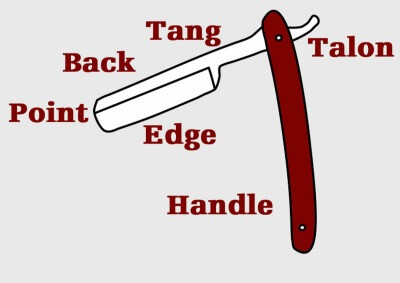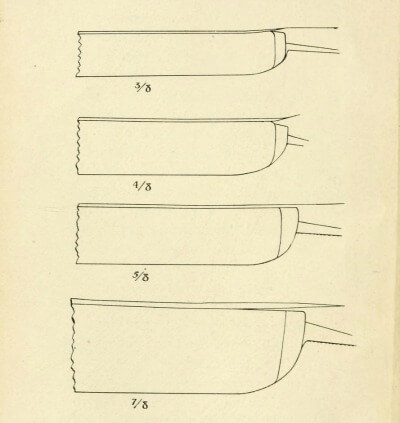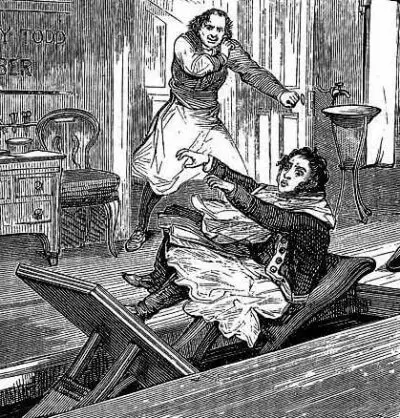Ever since I started doing shaving videos I’ve been getting emails requesting one about straight razors. To tell you the truth though, I’m not very good at using a straight razor. But let me show you the basics.
Straight Razor Basics
First lets look at the major parts of a straight razor and the basics of their design. There are some variations, mostly in vintage razors, but here are the most common things you’ll find.

The major parts of a straight razor include the scales, the razor’s blade edge, the point, the spine, the shank, and the tang. You may see some differences in labelling–like where the tang is– but these seem to be the most common descriptions.

Let’s take a closer look at the width of the blade edge. Blades can come in different sizes, ranging from one inch all the way down to ⅜ inch. Generally speaking the smaller widths provide more control than the wider ones. The most common size is ⅝ inch.
The end of the blade, the point, may have a variety of shapes including a Barbers Notch or a Spanish Point for maneuvering around mustaches, a French point, a Spike point, or a Square point. Most of these variations are in vintage razors. Today most new straight razors have a simple rounded point or a square point.
If you read straight razor descriptions you’ll often see references to the grind. This is the shape. thickness, and flex of the blade edge. The wedge type is the thickest, least flexible ground type. Grinds get progressively thinner until you reach the full-hollow–or even extra hollow–type. Some say that thicker grinds such as a quarter hollow are easier for the new user to shave with as it is more stable. On the other hand it provides less feedback to the shaver which could nicks or cuts more likely. Thinner grinds such as extra hollow provide more tactile feedback and some say the are easier to re-sharpen, but they also can bend or spring more easily, making a consistent shave harder to accomplish.
Next lets talk about metallurgy. The two most common metals used in straight razors are carbon steel and stainless steel. Carbon steel is more flexible but can rust if it’s not properly maintained. Stainless steel is easier to care for and might hold a cutting edge a bit longer.
Selecting a straight razor is to strike a balance between control, stability, and tactile feedback.
Buying A Straight Razor
Do yourself a favor and buy your first straight razor from an established, reputable source. Use your favorite search engine to look for discussions and reviews and you will soon find them. And be sure you look for a razor that is labeled as “shave ready”. If you don’t see that term assume that it’s not (contact the seller for clarification if you are interested): trust me, you don’t want to go about learning to sharpen razors yet–that’s a whole different animal. Count on spending at least $75 for a new, sharpened straight razor. Anything less and the odds are you’re buying a razor-shaped letter opener. Be aware that razors produced in Pakistan and China tend to be poorly made, with soft metals that won’t hold an edge, though Gold Dollar and Double Arrow razors (both made in China) have their fans.
What About Replaceable Blade Straight Razors?
You may have seen razors that look like a straight razor but use replaceable blades. These are often termed “shavette’s” after the Dovo Shavette and while they seem like a less expensive option and don’t require sharpening or stropping, they may not give you the straight razor experience you’re looking for–they just don’t have the weight and balance of a real straight razor. But they’re popular with barbers because there is no blade maintenance, and state or local law may require them anyway. Shaving with one of these razors may actually be more difficult than shaving with a genuine straight razor.
Plastic models like the Shavette are very light and don’t provide the heft and balance of a real straight razor. Many of these razors use a DE blade cut in half. That can make the blade edge unstable (not to mention uneven blade exposure) and overly flexible. Models that have the ability to use stiffer custom blades may help a bit.
Metal models like the Parker may help a little more, with better weight and balance. This model is also getting popular with barbers.
Finally, all-metal models with specially made blades like the Feather Artist Club may come reasonably close to a straight razor experience but the price
will approach–or even surpass–that of a regular straight razor.
What About “Kamisori” Razors?
Kamisori razors are Japanese-style straight razors. They’re out of the scope of this article but if you want to learn more take a look at THIS post from last year.
Stropping
Stropping does not sharpen a razor. It helps keep the cutting edge of the blade aligned and polishes the edge, removing tiny amounts of lather residue and some mineral deposits. Most shavers strop their blade before every use, though this may not be strictly necessary–some strop their blades the night before the shave and some find that they don’t need to strop before each use but rather every-other-use.
Stropping is usually done on a piece of specially prepared leather. The leather can be secured on one end and held taut (a “hanging strop”) or mounted on a flat surface (a “paddle strop”). Rest the blade of the razor flat onto the leather by the shank (or tang depending on how it’s termed) and, without pressing down, draw the razor in the opposite side of the blade edge. Then roll the razor on its back over to the other side and repeat the draw in the opposite direction. You’ll want to do about 50 of these full forward-and-back cycles.
The width of the leather can vary as well, from two inches to three inches. If the width of the leather is less than the width of the blade you will have to move the razor from side-to-side as it is drawn forward and back. This “X Pattern” will ensure the entire blade edge is prepared.
Shaving With A Straight Razor
While you are learning the skills necessary to shave with a straight razor you will really benefit from paying close attention to what you do before the shave starts. You will want to prepare your face really well and make the best lather possible–this is not the time to skimp on preparations! Take a long shower before beginning and take extra time thoroughly applying lather. No canned shave cream here, please! Don’t shave with a thick growth of stubble or you will only make it harder on yourself. One or two day’s growth will be more than enough to start with.

Hold the razor with your dominant hand. If you need to reposition your fingers slightly that’s fine, just make sure you can hold the razor firmly but comfortably. Start shaving on the same side of the face you are holding the razor with, so if you’re right-handed you will be shaving the right side of the face first.
Stretch the area you are going to shave flat and taut in the direction opposite of shaving with the other hand, then rest the blade so its almost flat on the skin. Roll the razor slightly while moving the blade down, until you find the angle that is most comfortable to shave with. Be sure to lock your wrist and move the blade and your arm as a single unit.
The classic movement is to shave downward. But if you need to you can change direction slightly to better follow the grain of your stubble.
As you maneuver around your face try to envision it as a diamond, with you shaving the facets and avoiding the corners whenever possible. But remember you’re going to have to adjust the position of the razor in your hand to match the angle needed to shave each facet. One of the key skills you will have to develop is holding the blade firmly while still being able to rotate it slightly and maintaining the correct pressure on the skin, all at the same time. It’s a balancing act that can take some concentration.
Once you finish the dominant side of the face you can move to the opposite side. Here there is a choice on how to grip the razor. One way is to continue to hold the razor in the dominant hand with the end is facing the nose. The other way is to simply switch the razor to the other hand and use it just like the dominant hand. Try it both ways to see what is most comfortable to you.
Shaving the center of the face can be the most challenging because of the many curves in the area and the generally tougher stubble that usually grows there. You may have to change razor positions several times to finish that area.
While you are learning to shave with a straight razor it is probably best to stop at this point and use a razor you’re more familiar with to clean up remaining stubble. Later you may want to try relathering and repeating this pass for a slightly closer shave. Remember that it may take some time to develop the skill necessary for a good, consistent shave so it’s best to do it in stages.
When you’re ready for a closer shave, add an upward pass. You will need to grip the razor slightly differently and use a slightly shallower angle. For this pass I find it more comfortable to start on the side opposite that of your dominant hand.
After The Shave
A straight razor needs some attention after the shave too, to maintain its condition. Carefully wipe the blade clean with a dry tissue or towel. Don’t forget to dry the inside of the scales as well, so water doesn’t get to the blade when the razor is in its closed position. Then store the razor for its next use. If you’re not going to use the razor for a while you may want to coat the blade with a thin coating of light oil (baby oil will work fine) or even petroleum jelly to help prevent corrosion.
And there you have the basics of shaving with a straight razor. Be sure to leave your questions or comments. I’ll do my best to address them.
Other Places To Look For Information
There are some really good resources for learning the ins and outs of shaving with a cut throat razor though, and I have listed some below. I’ll edit this list as additional resources come to my attention.
Arguably the most comprehensive resource for information on straight razors is Sharp Razor Palace. With Wiki’s, FAQ’s, and forums on pretty much every aspect of straight razors, SRP is one place you should know about.
Free texts about straight razor shaving include Chris Moss’ guide and a vintage book on shaving at archve.org.
The Shaving Room (UK), Shave My Face, and Badger & Blade forums have active straight razor communities. Be sure to check out Sharpologist’s list of forums and blogs for more.
Some good video channels include Lynn Abrams’ Straight Razor Place, Geo/Shavenation’s Geofatboy, and Reddit’s Wicked Edge.
Lynn Abrams also sells a DVD with detailed information on straight razors.
Related Posts:
A Kamisori Primer
What Are Cotton Strops Used For?

Is there a rule of thumb for how often one must hone or sharpen a straight razor? Seems like if you are having them professionally honed that could get quite expensive long term.
I have heard anywhere from 6 months to 2+ years. I imagine it depends on how well the blade was stropped and the metallurgy of the blade.
You could learn to do it yourself. It’s a great skill to have and could save you a fair bit of money. There are some good guides in the resources above.
I want one straight RAZOR. Please provide some websites regarding this or email Me.
When I switched from a 5-blade Schick razor to a straight razor, all the redness and irritation from my face was gone. My face felt smoother and softer – and a lot of people noticed the difference. I can’t believe I used that crap for 14 years of my life. I also bought a shavette for travel purposes. I use hand-made goat milk shaving soap and my skin has benefited greatly from it.
I really liked the video and used it in our straight razor shaving guide. Thank you!
Great video for novices on learning to use straight razors. Regarding “Carefully wipe the blade clean with a dry tissue or towel. Don’t forget to dry the inside of the scales as well, so water doesn’t get to the blade when the razor is in its closed position.”
It can be difficult to detect the presence of and get water out from between the scales and tang around the pivot. There are many posts from novices expressing their dismay upon 1st seeing rust or water spots on their new razor from getting water into the pivot/scale/tang area. It is best to never let water get between the scales, and to do everything necessary to be certain that any water has been removed from this area before razor oiling and storage.
Excellent article and video. This should be must reading before a person gets involved in shaving with a straight razor.
Another excellent resource for straight razors is Glen at
http://www.GemStarCustoms.com
Pingback: How to Shave with a Straight Razor-Mantic59
Excellent article! I have been using a 1959 Gillette Fatboy DE razor on my face and have been wanting to try a straight razor. While I wouldn’t dare try it for head shaving, I think you just convinced me to try it on my face!
Pingback: *Finally* Mantic's Straight Razor Video Primer
Pingback: How To Shave With A Straight Razor « rasage
Great video, I’ve been waiting for this one. About two years ago my brother gave me a couple of straight razor that had belonged to my Grandfather who had been a barber in Oklahoma City. I just looked at them for a long time. Finally, I sent one off to have it professionally sharpened. They guys at Classic Shave (http://www.classicshaving.com) did a great job. So I was ready to give it a try. It was a little scary at first, but once I got the hang of stropping it and using it, I fell in love with straight razor shaving. Most weeks I use a DE razor ( usually a vintage Schick), but at least a couple days a week I use one of my strait razors. I put away my Grandpa’s razor and now switch between a vintage J.A. Henckels, Solignen, Zwillingerswerk and my Theirs Issard. I also use a Dragon Shavette when I’m in the mood. In my humble opinion, straight razor shaving and DE shaving is something every man should at least try. As for me, the closest, most relaxing shave I have is with my straight razors. Thanks Grandpa.
Wonderful article and vidi.
Excellent and very comprehensive video! Many thanks!
We’re in the same boat. I’ve tried to start shaving with straight razors several times. My wife got me a new one which was supposed to be pre-sharpened (it wasn’t) and I also picked one up at an antiques fair (it’s in great shape, albeit at least 50 years old).
The main problem with them is not the technique, in my opinion — it’s getting them and keeping them sharp enough. I think shaving with a safety razor develops fairly good technique for us. Sure, there are differences, but they’re surpassed with a bit of effort and patience.
I can’t find anyone in our city to sharpen straight razors. And even though I’ve bought a sharpening stone, I haven’t been able to sharpen them myself. And if they’re not sharp enough, they’ll pull on the hair something fierce, to the point of bringing you to tears. And they’ll irritate the face too.
If you discover any great videos that show people how to sharpen straight razors in proper detail, please post them to your blog. I think that’s the missing piece in the puzzle.
Raoul,
Have you given the services at Whipped Dog a look? He’s a great reputation and can work through the mails.
Excellent clip. When shaving with a straight (or even a DE) it might help to puff out your cheeks and around your lips to create a flat (or con caved outwards as opposed to inwards) surface or some cushioning with the air… try it out. It looks ridiculous but it helps.
Check out Lynn Abrhams(not sure of the spelling on the last name) on YouTube. He has several clips on how to sharpen a straight. In fact he is the Mantic/GeoFatBoy of straight razor shaving. I warn you though, the learning curve for straights is FAR bigger than that of safety razors…at least that has been my experience thus far. I’ve been using mine off and on for a month now, and I’ve yet to get as good a shave as I can with my Ikon Bamboo.
Comments are closed.